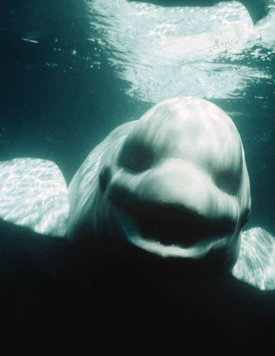The Whale that Spoke Human
Air Date: Week of October 26, 2012
 |
Whales are famous for their intelligence, and a new paper from neurobiologist Sam Ridgway argues that at least one beluga whale could imitate human speech patterns. Living on Earth's Emmett FitzGerald reports on Noc, the cetacean with the remarkable vocal powers.
Transcript
CURWOOD: It's Living on Earth - I'm Steve Curwood. Beluga whales are known as "canaries of the sea" because of their musical voices and talkative nature. Legend has it that sailors believed the songs of belugas were the voices of drowned men speaking from beneath the waves.
Well, new research suggests that belugas may be able to sound human, giving some basis to these old maritime myths. Living on Earth’s Emmett FitzGerald updates the yarn.
FITZGERALD: If there's anybody out there who speaks whale - it's Dr. Sam Ridgway. He’s been studying the behavior of marine mammals for a very long time.
RIDGWAY: I recently figured it out… it’s been 52 years and 8 months. I worked with mainly bottlenose dolphins, California sea lions, and white whales. I call them white whales, I like the name better than beluga whales.
FITZGERALD: Dr. Ridgway is a neurobiologist and the President of the national Marine Mammal Foundation, and he’s just published a paper in the journal Current Biology. The paper argues that belugas are capable of imitating the speech patterns of humans. This research began way back in 1984. Dr. Ridgway was working with a group of three belugas from the Arctic when something very strange occurred.
RIDGWAY: One day, we started hearing noises, like a distant conversation on another pier here in San Diego Bay. We didn’t think much of it because we thought it was a human conversation. But then, a diver who was using underwater communications equipment, got out of the water and said, ‘who told me to get out?’ and he was next to this whale’s pen and the dive supervisor had not said anything or told him to get out and now the only alternative was the whale.
FITZGERALD: The researchers determined that the human-like noises were coming from a whale they called No-see-um. Noc for short, after the swarms of maddening insects that thrive in the Arctic. Once he was moved to San Diego, Noc spent a lot of time with divers, trainers, and veterinarians. At some point, it seems, the white whale began to mimic the sounds he heard coming from his human caretakers. These new noises were several octaves lower than his normal register.
So, Noc needed to develop a special method to create them. He learned how to over-inflate two air sacs above his nasal cavity – a behavior never before seen in beluga whales. Dr. Ridgway compares Noc’s new voice to another famous musician.
RIDGWAY: One example I’d give is a human trumpeter - normal trumpeters play music and they do it very well, but Louis Armstrong could make the trumpet talk and make pops and do all sorts of unique things, so this is a whale that taught his vocal system to do something a bit different.
FITZGERALD: We’ve got a recording of Noc speaking human. Here it is:
[SOUNDS OF WHALE]
FITZGERALD: Dr. Ridgway doesn’t argue that Noc is saying real words, but these noises are very different from normal beluga songs:
[SOUND OF BELUGAS, HIGH SQUEaKS]
FITZGERALD: It wasn’t only the unusual sounds that Noc made. Dr. Ridgway did a visual analysis of patterns in the whale’s speech. When viewed through a device called a spectrogram, Noc’s voice patterns looked remarkably human. Though we may never have a conversation with a whale, Dr. Ridgway believes we can already communicate with whales in basic ways.
RIDGWAY: We train them to make a certain sound and they tell us when they hear another sound. So, we can communicate on that level. Who knows to what extent we can learn to communicate with these animals. We hope that others will take this up and do more rigorous work.
FITZGERALD: Scientists still have a lot to learn about whale communication. Although Noc died five years ago, Dr. Ridgway hopes that the strange noises he created will inspire further research into these curious ocean creatures. For Living on Earth, this is Emmett Fitzgerald.
Links
More about Dr. Sam Ridgway and the National Marine Mammal Foundation
Living on Earth wants to hear from you!
Living on Earth
62 Calef Highway, Suite 212
Lee, NH 03861
Telephone: 617-287-4121
E-mail: comments@loe.org
Newsletter [Click here]
Donate to Living on Earth!
Living on Earth is an independent media program and relies entirely on contributions from listeners and institutions supporting public service. Please donate now to preserve an independent environmental voice.
NewsletterLiving on Earth offers a weekly delivery of the show's rundown to your mailbox. Sign up for our newsletter today!
 Sailors For The Sea: Be the change you want to sea.
Sailors For The Sea: Be the change you want to sea.
 The Grantham Foundation for the Protection of the Environment: Committed to protecting and improving the health of the global environment.
The Grantham Foundation for the Protection of the Environment: Committed to protecting and improving the health of the global environment.
 Contribute to Living on Earth and receive, as our gift to you, an archival print of one of Mark Seth Lender's extraordinary wildlife photographs. Follow the link to see Mark's current collection of photographs.
Contribute to Living on Earth and receive, as our gift to you, an archival print of one of Mark Seth Lender's extraordinary wildlife photographs. Follow the link to see Mark's current collection of photographs.
 Buy a signed copy of Mark Seth Lender's book Smeagull the Seagull & support Living on Earth
Buy a signed copy of Mark Seth Lender's book Smeagull the Seagull & support Living on Earth

